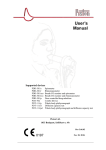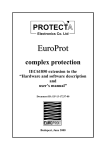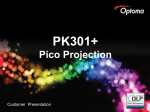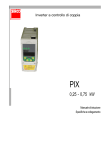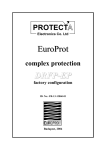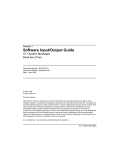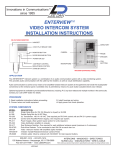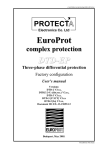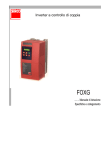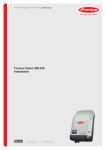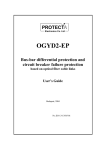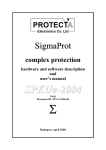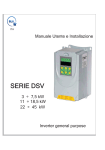Download DTI3-KF-EP angol fordítása
Transcript
PROTECT Electronics Co. Ltd EuroProt complex protection DTI3-MV-EP factory configuration ID. No.: EH-13-13608-01 Budapest, 2004 DTI3-KF-EP PROTECT User’s guide Electronics Co. Ltd CONTENTS 1 APPLICATION.........................................................................................................................................3 1.1 1.2 2 FEATURES...........................................................................................................................................3 MAIN HARDWARE FEATURES ..............................................................................................................5 THE PROTECTION FUNCTIONS ........................................................................................................6 2.1 DEFINITE TIME OVERCURRENT PROTECTION FOR PHASE FAULTS .........................................................6 2.1.1 Realisation of the three phase, two stage overcurrent protection.................................................6 2.1.2 Setting guide ...............................................................................................................................14 2.1.3 Tests of the overcurrent protection .............................................................................................15 2.2 EARTH-FAULT ZERO SEQUENCE OVERCURRENT PROTECTION ...........................................................16 2.2.1 Zero sequence overcurrent protection – method of operation....................................................17 2.2.2 Setting guide for the zero sequence overcurrent function...........................................................23 2.2.3 Checking the earth-fault overcurrent protection ........................................................................25 2.3 ZERO SEQUENCE OVERVOLTAGE FUNCTION ......................................................................................26 2.4 PHASE OVERVOLTAGE AND UNDERVOLTAGE FUNCTION ...................................................................26 2.4.1 Method of operation ...................................................................................................................26 2.4.2 Setting guide for the over/undervoltage function........................................................................31 2.4.3 Testing the over/undervoltage function ......................................................................................32 2.5 ADDITIONAL IMPLEMENTED FUNCTIONS ...........................................................................................33 2.5.1 Integrated tripping matrix ..........................................................................................................33 2.5.2 The PROTLOG equations ...........................................................................................................35 2.5.3 Application of signals from the digital inputs.............................................................................37 2.5.4 Application of output relays........................................................................................................38 2.5.5 Circuit breaker control function .................................................................................................40 2.5.6 The disturbance recorder function..............................................................................................40 2.5.7 The free programmable timers....................................................................................................42 2.5.8 The LED signals..........................................................................................................................42 2.5.9 Displayed system messages.........................................................................................................44 2.5.10 Displayed values (Summary)..................................................................................................45 2.5.11 Self check function .................................................................................................................47 3 COMMUNICATION WITH THE DEVICE ........................................................................................48 3.1 THE LCD MENU SYSTEM ..................................................................................................................48 3.1.1 The “Events” menu.....................................................................................................................48 3.1.2 The “Test” menu.........................................................................................................................49 3.1.3 The “Param.” menu ...................................................................................................................50 3.2 CONNECTION TO AN EXTERNAL PC...................................................................................................51 4 THE LOCAL SCADA FUNCTION ......................................................................................................52 5 DESIGN OF DTI-MV-EP DEVICES ....................................................................................................52 6 ORDERING DATA.................................................................................................................................53 Compiled by: Approved by: Kornél Petri Dr. László Eperjesi Date: 11.04.2004. Page: 2/53 DTI3-KF-EP PROTECT User’s guide Electronics Co. Ltd 1 Application The members of the EuroProt complex protection series are basically modular devices. The modules are assembled and configured according to the required protection functions. This manual describes the specialities of one of the numerous applications: the DTI-MV-EP factory configuration (and its versions). The general user’s manual for the EuroProt devices is the document „EPCP-2004 EuroProt complex protection, hardware and software manual”, (further „EPCP-2004”), which provides all common information to the members of the EuroProt complex protection series. The DTI-MV-EP complex numerical device made by PROTECTA Co. Ltd. is preconfigured for a three-phase definite time overcurrent protection with earth-fault protection. This device can be applied in all areas of the electric power system, where overcurrent protection is needed to protect against short-circuits, overload or earth fault. The additional supervisory and control functions (SCADA) extend the device to a complex field unit. 1.1 Features The main features of DTI-MV-EP complex protection are as follows: ! The protection part of the complex device implements the following functions: − − − − ! ! ! three-phase, definite time overcurrent protection, high current setting stage (I>>), three-phase, definite time overcurrent protection, low current setting stage (I>), zero sequence overcurrent function, high current setting stage (3Io>>), zero sequence overcurrent function, low current setting stage (3Io>>), can be set for directional earth-fault protection as well, − zero sequence overvoltage protection, − over/undervoltage protection based on the phase voltages. Features of the protection functions: − all functions can be individually switched to be operative or inoperative; − the setting value and time delay of the functions can be set independently of each other, − the zero sequence low current setting stage can be set for directional earth-fault protection as well. Additional features: − trip matrix, − PROTLOG equations. The features of the supervisory and control functions implemented in the device are as follows: − the supervisory and control functions are implemented in a dedicated processor, located on the Central Processing Unit (CPU) of the device, − the optional large graphic LCD realises full-scale local control unit for the bay, Compiled by: Approved by: Kornél Petri Dr. László Eperjesi Date: 11.04.2004. Page: 3/53 DTI3-KF-EP PROTECT User’s guide Electronics Co. Ltd ! ! ! ! ! ! − the supervisory and control functions are as follows: − control of switching devices: − local and remote operation, − interlocking functions, − generation of status signals, − event logging, − protective command transmission, − communication with the intelligent graphic display, − transmission of protection signals to the supervisory and control system, − transmission of commands signals from the supervisory and control system, and their execution, − receipt of commands from the graphic LCD and their execution. Continuous and cyclic self-check functions are implemented; the supervision is extended to the current transformer circuits and to the trip circuits as well. The same software configuration is loaded in all configurations of the device. The individual functions of the software are to be set by parameters according to the requirements. The versions are basically determined by the hardware configuration. The integrated event recorder can store up to 50 evaluated events and up to 300 digital events with 1 ms time resolution. An integrated real-time clock is implemented with battery supported RAM. The clock can be synchronised by external PC or by the supervisory and control system, and additionally a Word Time Synchroniser (GPS-OP) produced by PROTECTA Co. Ltd can be ordered optionally. The integrated disturbance recorder of the CPU module can store up to 11 records, the total time of which is about 10 s. The device implements several measuring functions based on the available analogue signals. Compiled by: Approved by: Kornél Petri Dr. László Eperjesi Date: 11.04.2004. Page: 4/53 DTI3-KF-EP PROTECT User’s guide Electronics Co. Ltd 1.2 Main hardware features The DTI-MV-EP complex digital overcurrent protection is a full numerical system, based on powerful microcontrollers. Within the limits of the hardware the functions and the versions are determined by the software. The different hardware versions of the device – with identical software – cover practically all usual protective functions of the medium voltage part of the electric power system. The hardware versions are as follows: ID 3FIo 3FU xK XD UKE Meaning 3 phase + zero sequence current measurement (the zero sequence current can be directed by calculated Uo zero sequence voltage) 3 phase voltage measurement (calculated Uo) number of relay outputs (max. 24) number of optically isolated inputs (max. 32) unit for trip circuit supervision The maximum possible configuration: EuroProt complex protection: DTI-MV-EP factory configuration HW version: 3FIo-3FU-24K-32D-UKE Minimum configuration: EuroProt complex protection: DTI-MV-EP factory configuration HW version: 3FIo -8K-42TE The design, and the man-machine interface of the device is described in „EPCP-2004” manual. The man-machine interface of the device is the integrated 2x16 character LCD, the simple keyboard with 6 pushbuttons and the 7 LED-s on the front panel. The device can be supervised easier with a connected PC, which runs the windows-based operating program „Protect for Windows”, developed by Protecta Co. Ltd. The user’s manual for all these possibilities is the „EPCP-2004” documentation. The medium for the external communication is the 2 kV isolated serial RS 232 interface located on the front panel of the device, or the two integrated fibre optic interfaces, connector son the back panel. For the serial communication please find detailed information in the „EPCP-2004” documentation. Compiled by: Approved by: Kornél Petri Dr. László Eperjesi Date: 11.04.2004. Page: 5/53 DTI3-KF-EP PROTECT User’s guide Electronics Co. Ltd 2 The protection functions The DTI-MV-EP complex numerical protection implements the following protection functions: • • • • Definite time overcurrent protection for phase faults Zero sequence overcurrent protection for earth-faults (with optional direction function) Zero sequence overvoltage protection Over/undervoltage protection for phase voltages These functions are independent of each other, they can be set individually. The functions can be individually set to be operative or inoperative. The following chapters describe the protection functions. 2.1 Definite time overcurrent protection for phase faults One of the basic functions of the complex protection is the definite time overcurrent protection for phase faults. The algorithm determines the basic harmonic component of the phase currents using Fourier method, and this value is compared with the settings. If the basic harmonic content of one phase current is above the setting, the function starts the timer. When the pre-set time is over the function generates trip command. 2.1.1 Realisation of the three phase, two stage overcurrent protection The DTI3-MV-EP factory configuration of the EuroProt devices implements a three-phase, two stage definite time overcurrent protection. The measurement is performed in all three phases independently of each other, and the comparison with the two setting values (high current setting, low current setting) is performed individually as well. The measurement of the elapsed time however is common for all phases, and the trip command is issued common for the three phases as well. 2.1.1.1 Analogue inputs of the function This function measures the three phase currents: Ir Is It Compiled by: Approved by: Kornél Petri Dr. László Eperjesi Date: 11.04.2004. Page: 6/53 DTI3-KF-EP PROTECT User’s guide Electronics Co. Ltd 2.1.1.2 The parameter setting The function needs setting of the following parameters: Name LCD PIn I> /In[CTprot) = % 20 2500 5 PInn I>> /In[CTprot) = % 20 2500 5 PAV CTprN ['CTprot] = A 15 15000 5 PTIn t (I>) = ms 0 60000 10 PTInn t (I>>) = ms 0 60000 10 E_InEng (setting with PROTLOG equation only!) (Setting with PROTLOG equation only!) I>>[t] latching: /+=yes/ 0 1 1 0 1 1 - + - + E_InnEng PMxsInntOnt PMxsIntOnt Min Max I>[t] latching: /+=yes/ Step Meaning Setting of the low current setting stage related to the CT rated current Setting of the high current setting stage related to the CT rated current CT primary rated current related to 1A or 5A secondary value Selective time delay of the low current setting stage Selective time delay of the high current setting stage Enabling of the low current setting stage Enabling of the high current setting stage Latching of the matrix row for the high current setting stage time-over Latching of the matrix row for the low current setting stage time-over Parameter setting of the function on the „On-line” PC screen of the Protect for Windows software: Fig. 2-1. Parameter setting /1 Compiled by: Approved by: Kornél Petri Dr. László Eperjesi Date: 11.04.2004. Page: 7/53 DTI3-KF-EP PROTECT User’s guide Electronics Co. Ltd The enabling of the functions is solved with „PROTLOG” logic equations. As an example the enabling of the high current setting stage can be: Fig. 2-2. 2.1.1.3 Enabling the functions with „PROTLOG” logic equation Outputs of the function The functions deliver status signals indicating the operation. Among others these will be the inputs (rows) of the software matrix. These inputs can be marshalled with matrix programming to the outputs (columns) of the matrix. The status signals of the functions can be inputs of the „PROTLOG” logic equations as well. The matrix rows of the phase overcurrent protection function are: Matrix row Explanation Mx I(rst)>> Starting of the high current setting stage in any of the phases Mx I(rst)> Starting of the low current setting stage in any of the phases Mx (rst)>>[t] Time-over in the high current setting stage (trip command) Mx I(rst)>[t] Time-over in the low current setting stage (trip command) These signals can be marshalled with the software matrix to the output relays of the device. Fig 2-3 below shows that output relay contact No.1 outputs the trip command. Starting of the high current setting stage is signalled with contact No. 2, and contact No. 3 signals starting of the high current setting stage. Compiled by: Approved by: Kornél Petri Dr. László Eperjesi Date: 11.04.2004. Page: 8/53 DTI3-KF-EP PROTECT User’s guide Electronics Co. Ltd Fig. 2-3. Marshalling of the outputs of the function (matrix rows) to the output relays of the device (matrix columns) 2.1.1.4 Inputs of the PROTLOG equations: Input Explanation Starting of the high current setting stage in the indicated phase Ir>> Is>> It>> Ir> Is> It> I>>[t] I>[t] 2.1.1.5 Starting of the low current setting stage in the indicated phase Time-over in the high current setting stage (trip command) Time-over in the low current setting stage (trip command) The displayed information Displayed information on the integrated LCD of the device, in the „Test” menu: Measured analogous signals: LCD information Ir[A]= Is[A]= It[A]= Explanation Primary current in phase R expressed in Amperes Primary current in phase S expressed in Amperes Primary current in phase T expressed in Amperes Compiled by: Approved by: Kornél Petri Dr. László Eperjesi Date: 11.04.2004. Page: 9/53 DTI3-KF-EP PROTECT User’s guide Electronics Co. Ltd Binary signals on the PC screen: Signal I>>enabled : Ir>> start : Is>> start : It>> start : I>>[t] timeout: I> enabled : Ir> start : Is> start : It> start : I>[t] timeout : Explanation High current setting stage enabled Starting of the high current setting stage in phase R Starting of the high current setting stage in phase S Starting of the high current setting stage in phase T Trip command of the high current setting stage (time-over) Low current setting stage enabled Starting of the low current setting stage in phase R Starting of the low current setting stage in phase S Starting of the low current setting stage in phase T Trip command of the low current setting stage (time-over) The „On-line” screen of the Protect for Windows program shows this information, as indicated in Fig. 2-4. (Information related to other protection functions are masked in the Figure): Fig. 2-4. On-line data /1 Currents are indicated in primary Amperes. In case of overcurrent stages „+” character signals staring of the function and the generation of the trip command. 2.1.1.6 Messages of the function: There is only one message related to the function: Trip command! To enable this message a „PROTLOG” logic equation must be composed for the „Trip command” logic variable. Fig. 2-5 sows an example: Compiled by: Approved by: Kornél Petri Dr. László Eperjesi Date: 11.04.2004. Page: 10/53 DTI3-KF-EP PROTECT User’s guide Electronics Co. Ltd Fig. 2-5.PROTLOG equation for the message 2.1.1.7 Event recording The event recorder function records the following events with time stamp. See details of event recording in the „EPCP-2004 documentation. The integrated LCD of the device can display the following messages: "I>>R start "I>>S start "I>>T start "I>R start "I>S start "I>T start "I>[t] timeout "I>>[t] timeout 2.1.1.8 " " " " " " " " Evaluated events The Protect for Windows software displays the evaluated event in a separate window according to Fig. 2-6.: Compiled by: Approved by: Kornél Petri Dr. László Eperjesi Date: 11.04.2004. Page: 11/53 DTI3-KF-EP PROTECT User’s guide Electronics Co. Ltd Fig. 2-6. Evaluated events /1 2.1.1.9 Event counters The phase overcurrent function involves the following counters (displayed on the integrated LCD of the device): I>[t] counter : 8 I>>[t] counter : 3 The counter values are displayed in the „On-line” PC screen as shown in Fig. 2-7.: Fig. 2-7. Counters /1 2.1.1.10 LED indication The operation of the functions integrated into the device is indicated by seven LED-s located on the front panel. The LED-s shown in the following table are related to the phase overcurrent protection (LEDs are numbered from top to bottom): LED No. 4 5 LED text IS IT Explanation Starting in phase S Starting in phase T Compiled by: Approved by: Kornél Petri Dr. László Eperjesi Date: 11.04.2004. Page: 12/53 DTI3-KF-EP PROTECT User’s guide Electronics Co. Ltd 6 7 2.1.1.11 I>> I> High set current stage start Low set current stage start Signals recorded in the disturbance recorder The integrated disturbance recorder records the following signals: Analogue signals: Signal Ir Is It Digital signals: Signal Ir>> Is>> It>> I>>[t] Ir> Is> It> I>[t] % % % Explanation Current in phase R as percent of the CT rated current Current in phase S as percent of the CT rated current Current in phase T as percent of the CT rated current Explanation High current setting stage start in phase R High current setting stage start in phase S High current setting stage start in phase T High current setting stage time-over (trip) Low current setting stage start in phase R Low current setting stage start in phase S Low current setting stage start in phase T Low current setting stage time-over (trip) Compiled by: Approved by: Kornél Petri Dr. László Eperjesi Date: 11.04.2004. Page: 13/53 DTI3-KF-EP PROTECT User’s guide Electronics Co. Ltd 2.1.2 Setting guide The parameters to be set are described in chapter 2.1.1.2. The following guider refers these parameters by the „Parameter name”. PAV This is the primary rated current of the CT. This setting is not needed for the protection decision about trip command; the value is used only for scaling the measured values for displaying. The algorithm supposes that the secondary rated CT value is identical to the rated current of the device (1 A or 5 A). In case this is not valid (e.g. 1 A CT supplies a 5 A current input), then the primary rated current must be rescaled according to the rated current of the device. Pin Low current setting for the phase fault overcurrent protection, related to the input rated current, calculated in [%]. PInn High current setting for the phase fault overcurrent protection, related to the input rated current, calculated in [%]. PTInn Time delay for the high current setting stage (definite time). The parameter is given in [ms]. The time delay must be co-ordinated to the other protection setting on the network. The time delay is defined as an additional time delay, id does not include the calculation time of the algorithm. PTIn Time delay for the low current setting stage (definite time). The parameter is given in [ms]. The time delay must be co-ordinated to the other protection setting on the network. The time delay is defined as an additional time delay, id does not include the calculation time of the algorithm. E_InnEng The function must be enabled using „PROTLOG” equation (similar example see in Fig. 2-2). The high current setting stage must be enabled individually. E_InEng The function must be enabled using „PROTLOG” equation (similar example see in Fig. 2-2). The low current setting stage must be enabled individually. PMxsInntOnt, PMxsIntOnt Setting for latching of the high and low current setting stages individually. If latching is set, then the „on” state is kept even if the current drops below the setting level. Resetting is possible with acknowledgement only, if the current drops below the setting value. Acknowledgement must be programmed with PROTLOG equation, as indicated in Fig. 2-22. (See below). Compiled by: Approved by: Kornél Petri Dr. László Eperjesi Date: 11.04.2004. Page: 14/53 DTI3-KF-EP PROTECT User’s guide Electronics Co. Ltd 2.1.3 Tests of the overcurrent protection For testing it is advisable to disable the other protection functions, and the overcurrent protection stages must be enabled using PROTLOG equations (similar examples see in Fig. 2-2). Before testing check parameter setting, especially the marshalling of the status signals to the relay outputs. The tests can be performed using a single phase current or with a three-phase test set as well. The function measures and displays the basic harmonic value of the measured currents. The measured values can be seen on the integrated LCD in the „Test” menu item, or they can be seen on the „On-line” screen of the connected PC, using the „Protect for Windows” software. The algorithm operates with the RMS value of the basic harmonic current component. If the shape of the current is not sinusoid, there can be considerable measured differences between the measured values of an independent measuring instrument and the displayed values. It is advised to use a test set, generating pure sinusoid test currents. If the current setting is below the continuous overload capability of the input current transformers, the tests can be performed using slowly increasing currents. In case of higher current dynamic test method must be applied. The test current must be switched on the input, and check no operation at 95 % setting values, and no operation at 105 % setting. To check the time delay it must be considered that the time setting is an additional time delay, it does not include the operation time of the measuring algorithm. This measurement can be performed using currents twice of the current setting. Compiled by: Approved by: Kornél Petri Dr. László Eperjesi Date: 11.04.2004. Page: 15/53 DTI3-KF-EP PROTECT User’s guide Electronics Co. Ltd 2.2 Earth-fault zero sequence overcurrent protection One of the main functions of the complex DTI-MV-EP protection is the earth-fault zero sequence overcurrent protection. The device measures the zero sequence current in two different ways: the zero sequence current is received by an independent analogue input, and the zero sequence current is calculated as the sum of the three phase currents. This function is a two stage definite time overcurrent protection. The earth-fault protection is similar to the phase fault overcurrent protection, but the operation of the low current setting stage – besides the enabling – has some special conditions as well: ! ! no operation of the phase-fault current stages, and if the directionality is enabled then − the zero sequence overvoltage function must start too and − the phase angle between the zero sequence voltage and the zero sequence current must be between the pre-set limits. The setting of the directional function needs determination of the lower and upper angle limits and the hysteresis. In case of exact angle measurement requirement the angle correction must be defined as well. The operation characteristics of the directional function and the meaning of the parameters are drawn on Fig. 2-8. Uo 3Io Fi min. 3Io Fi HIST. AT DROP OFF 3Io 3Io Fi max. RANGE OF OPERATION AT PICK UP 3Io 3Io Fi HIST. REMARK: The value of Fi min. can be above Fi max. E.g.: cos Fi characteristics: Fi min.=280° Fi max.=80° Fig. 2-8.The Fi(UoIo) setting. The zero sequence high current setting stage does not have directionality, and the only condition of the operation is the enabling. Compiled by: Approved by: Kornél Petri Dr. László Eperjesi Date: 11.04.2004. Page: 16/53 DTI3-KF-EP PROTECT User’s guide Electronics Co. Ltd 2.2.1 Zero sequence overcurrent protection – method of operation The operation of the earth-fault zero sequence overcurrent protection in the DTI-MV-EP factory configuration is independent of the operation of phase-fault stages. 2.2.1.1 Analogue inputs of the function In one way the function calculates the zero sequence current (3Io) as the sum of the phase currents, in the other way the zero sequence current is received from a core balance CT in a dedicated current input. Ir+Is+It Io In case of directionality the function calculates the sum of the phase voltages: Ur+Us+Ut Using Fourier algorithm the program calculates the base harmonic of the zero sequence currents received from both sources. The zero sequence current calculated as the sum of three phase currents is applied by the high current setting stage, the current measured in a dedicated current input sis used by the low current setting stage. At start of both stages the dedicated timers are started. If any of them runs out, the function issues the trip command. Compiled by: Approved by: Kornél Petri Dr. László Eperjesi Date: 11.04.2004. Page: 17/53 DTI3-KF-EP PROTECT User’s guide Electronics Co. Ltd 2.2.1.2 The parameter setting The protection function needs setting of the following parameters: 1.) On the integrated LCD: Name LCD PIon Io>/Ion[CToProt] = % 10 140 1 PIonn Io>>/Ion[CTProt] = % 20 2500 5 PAVo AvoPrN['CToProt]= 10 1000 1 PUon Uo>/Un[VTprot]% 10 110 1 PioUoFi Min PioUoFi Max PioUoFi Hiszt Fi(IoUo) min deg 0 359 1 Explanation Setting of the zero sequence low current setting stage, as percent of the rated CT current Setting of the zero sequence high current setting stage, as percent of the rated CT current The primary rated current of the zero sequence CT reduced to 100 mA, or 500 mA secondary value, used only to scale the displayed values Setting of the zero sequence overvoltage function, as percent of the rated voltage of the device Lower angle limit Fi(IoUo) max deg 0 359 1 Upper angle limit Fi(IoUo) hist deg 0 359 1 PioUoFi Komp PTIonn Fi(IoUo) comp /10 deg t (Io>>) = ms 0 3599 0 60000 PTIon t (Io>) ms 0 60000 PTUon t (Uo>) = ms 0 60000 E_Ion Eng (Setting with PROTLOG equation only!) (Setting with PROTLOG equation only!) (Setting with PROTLOG equation only!) (Setting with PROTLOG equation only!) E_Ionn Eng E_IonFi Eng E_Uon Eng Min Max = A Step Hysteresis of the angle measurement (drop-off ratio of angle decision) 1 Angle error compensation 10 High current setting stage time delay 10 Low current setting stage time delay 10 Zero sequence overvoltage stage time delay 1 Enabling of the low current setting stage 0 1 0 1 1 Enabling of the high current setting stage 0 1 1 Enabling of the directionality 0 1 1 Enabling of the zero sequence overvoltage stage Compiled by: Approved by: Kornél Petri Dr. László Eperjesi Date: 11.04.2004. Page: 18/53 DTI3-KF-EP PROTECT User’s guide Electronics Co. Ltd PMxsIonnt Io>>[t] latching: Ont /+=yes/ - + PMxsIontO Io>[t] latching: nt /+=yes/ - + Latching of matrix row for high current setting stage timeover Latching of matrix row for low current setting stage time-over 2.) Settings of the function on the „On-line” PC screen: Fig. 2-9. Parameter setting /2 2.2.1.3 Outputs of the protection function The functions deliver status signals indicating the operation. Among others these will be the inputs (rows) of the software matrix. These inputs can be marshalled with matrix programming to the outputs (columns) of the matrix. The status signals of the functions can be inputs of the „PROTLOG” logic equations as well. The matrix rows of the zero sequence overcurrent protection function are: Matrix row Mx Mx Mx Mx Mx Mx 3Io>> 3Io> 3Io>>[t] 3Io>[t] Uo> Uo>[t] Explanation Starting of the high current setting stage Starting of the low current setting stage High current setting stage time-over (trip command) Low current setting stage time-over (trip command) Starting of the zero sequence overvoltage stage Zero sequence overvoltage stage time-over (trip command) These signals can be marshalled to the outputs using the software matrix (see similar example in Fig. 2-5.). Compiled by: Approved by: Kornél Petri Dr. László Eperjesi Date: 11.04.2004. Page: 19/53 DTI3-KF-EP PROTECT User’s guide Electronics Co. Ltd 2.2.1.4 Inputs of the PROTLOG equations: Equation inputs Explanation Io>> Start of the high current setting stage Io> Start of the low current setting stage Io>>[t] High current setting stage time-over (trip command) Io>[t] Low current setting stage time-over (trip command) Uo> Start of the zero sequence overvoltage stage Uo[t] Zero sequence overvoltage stage time-over (trip command) 2.2.1.5 The displayed information As a secondary product of the function the following information can be displayed on the integrated LDC of the device or on the PC screen: Displayed information on the LCD using „Test” menu item: Measured analogue values: LCD Explanation IoMeasured [A]= Zero sequence current as measured on the dedicated input IoCalculated[A]= Zero sequence current calculated as the sum of the three phase currents Uosecondary[V]= The zero sequence voltage secondary value calculated as the sum of the three phase voltages Displayed status signals on the PC screen: Signal Io>>Enabled Io> Enabled IoFi> Enabled Io>> start Io> start Io>>[t]timeout Io>[t]timeout Explanation High current setting stage enabling Low current setting stage enabling Directional function enabling Starting of the high current setting stage Starting of the low current setting stage High current setting stage time-over (trip command) Low current setting stage time-over (trip command) The displayed information on the „On-line” PC screen of the Protect for Windows software (information concerning other protection functions is masked): Compiled by: Approved by: Kornél Petri Dr. László Eperjesi Date: 11.04.2004. Page: 20/53 DTI3-KF-EP PROTECT User’s guide Electronics Co. Ltd Fig. 2-10. On-line data /2 The enabled state is indicated by a „+” character, for the overcurrent stages a „+” character indicates starting or trip signal after time-over. 2.2.1.6 Messages of the function There is only one message related to the function: Trip command! To enable this message a „PROTLOG” logic equation must be composed for the „Trip command” logic variable. Fig. 2-5 sows an example. 2.2.1.7 Event recording The event recording function record the following events with time stamp, as displayed on the integrated LCD: Io>> start Io> start Io>[t] timeout Io>>[t] timeout Uo> start Uo>[t] timeout Uo>>[t] timeout 2.2.1.8 Evaluated events Compiled by: Approved by: Kornél Petri Dr. László Eperjesi Date: 11.04.2004. Page: 21/53 DTI3-KF-EP PROTECT User’s guide Electronics Co. Ltd The dedicated PC window displays the related information as show non Fig. 2-11. (The information related to other functions is masked): Fig. 2-11. Evaluated events /2 2.2.1.9 Counters This protection function operates the following counters (as displayed on the integrated LCD): Io>>[t] Io> [t] Uo> [t] Counter: Counter: Counter: This information is displayed on the „On-line” PC screen as shown on Fig. 2-12.: Fig. 2-12. Counters /2 2.2.1.10 LED indication Compiled by: Approved by: Kornél Petri Dr. László Eperjesi Date: 11.04.2004. Page: 22/53 DTI3-KF-EP PROTECT User’s guide Electronics Co. Ltd The operation of the functions integrated into the device is indicated by seven LED-s located on the front panel. The LED-s shown in the following table are related to the zero sequence overcurrent protection (LEDs are numbered from top to bottom): LED No. 8 2.2.1.11 LED text 3Io> Explanation Zero sequence overcurrent protection operated Signals recorded in the disturbance recorder This function generates the following information for the integrated disturbance recorder: Analogue signals: Signal Io % Digital signals: Signal Io>> Io>>[t] Io> Io>[t] Uo> Uo>[t] Explanation Measured zero sequence current as percent of the CT rated current Explanation Starting of the high current setting stage High current setting stage time-over (trip command) Starting of the low current setting stage Low current setting stage time-over (trip command) Starting of the zero sequence overvoltage function Zero sequence overvoltage function time-over (trip command) 2.2.2 Setting guide for the zero sequence overcurrent function The parameters to be set are described in chapter 2.2.1.2. The following guide refers to the parameters by the „Parameter name”. Pion Setting value of the low current setting stage related to the CT rated current. The value is expressed in percent [%]. Pionn Setting value of the high current setting stage related to the CT rated current. The value is expressed in percent [%]. PAVo The primary rated current of the dedicated zero sequence CT. This setting is not used by the protection function for protection decision; it is needed only for scaling the displayed measured value. The algorithm assumes that the secondary rated current of the CT is identical with that of the device (100 mA, 1A or 5 A). If the values are different than the primary value must be related to the rated current of the device. Compiled by: Approved by: Kornél Petri Dr. László Eperjesi Date: 11.04.2004. Page: 23/53 DTI3-KF-EP PROTECT User’s guide Electronics Co. Ltd Puon Setting value of the zero sequence overvoltage protection function, related to the rated input voltage of the device. The parameter is expressed in percent [%]. PioUoFiMin PioUoFiMax Lower and upper angle limit of the directional zero sequence earth-fault overcurrent protection. The angles are expressed in degrees. The setting range is 0 … 359°. (Negative angles can not be set.) The limits are explained in Fig. 2-8. The numerical value of the „FiMin” angle can be above the „FiMax” value. For example the realisation of a „cos Fi” function the possible setting can be „FiMin=280°”, „FiMax=80°” PioUoFiHiszt After starting the angle range of the function „opens” according to the hysteresis value expressed in degrees (angle drop-off ratio). See Fig 2-8. PioUoFiKomp With this parameter the angle errors of the VT and CT can be compensated. The meaning of this angle value is as follows: the VT angle error is subtracted from the CT angle error, and the compensating angle setting is the negative value of the subtraction. PTIonn Time delay for the high current setting stage. PTIon Time delay for the low current setting stage. PTUon Time delay for the zero sequence overvoltage function. E_IonEng E_IonnEng E_IonFiEng E_UonEng The individual functions, the sequence above is: zero sequence low current setting stage, zero sequence high current setting stage, zero sequence directionality, and zero sequence overvoltage function, must be enabled separately. To enable the functions PROTLOG equations must be composed (see Fig. 2-22.). The programming method of the PROTLOG equations is described in „EuroProt” EPCP-2004 manual. PmxsIonntOnt PmxsIontOnt These parameters set the latching of the high set and low set zero sequence overcurrent protection command outputs to the appropriate matrix rows. If the setting is „+”, which means that latching is set, then the signal value „1” does not reset after the disappearing of Compiled by: Approved by: Kornél Petri Dr. László Eperjesi Date: 11.04.2004. Page: 24/53 DTI3-KF-EP PROTECT User’s guide Electronics Co. Ltd the overcurrent state until acknowledgement. The acknowledgement is to be programmed with PROTLOG equation. An example is shown on Fig. 2-22. (See below). 2.2.3 Checking the earth-fault overcurrent protection For checking this function all other functions are advised to be disabled. When checking the low current setting zero sequence protection, take the fact into consideration, that there are other special conditions to be fulfilled as well: ! ! ! the zero sequence current is measured in the dedicated current input, the phase overcurrent protection function may not operate, and if the directionality is enabled, then the zero sequence overvoltage function must operate as well (in order to avoid wrong operation because of too low voltage value), so this function must be enabled as wee, and the angle between the voltage and current must be between the limits as well. The high current setting stage must be enabled, and the zero sequence current is calculated as the sum of the three phase currents. . For both stages the trip signals of the functions must be marshalled to the appropriate relay output(s) using the software matrix. The protection function measures and displays the basic harmonic of the zero sequence current. This value can be seen in the integrated LCD using the „Test” menu item, or on the „On-line” screen of the connected PC using the Protect for Windows software. The algorithm operates with the RMS value of the basic harmonic current component. If the shape of the current is not sinusoid, there can be considerable measured differences between the measured values of an independent measuring instrument and the displayed values. It is advised to use a test set, generating pure sinusoid test currents. If the current setting is below the continuous overload capability of the input current transformers, the tests can be performed using slowly increasing currents. In case of higher current dynamic test method must be applied. The test current must be switched on the input, and check no operation at 95 % setting values, and no operation at 105 % setting. To check the time delay it must be considered that the time setting is an additional time delay, it does not include the operation time of the measuring algorithm. This measurement can be performed using currents twice of the current setting. Compiled by: Approved by: Kornél Petri Dr. László Eperjesi Date: 11.04.2004. Page: 25/53 DTI3-KF-EP PROTECT User’s guide Electronics Co. Ltd 2.3 Zero sequence overvoltage function The integrated zero sequence overvoltage function is an integral part of the directional zero sequence overcurrent protection, but it can be applied as an independent function as well. See details in chapter 2.2. in connection with the directional zero sequence overcurrent protection. 2.4 Phase overvoltage and undervoltage function If the device contains voltage input module, then the algorithm measures the three phase voltages, and calculates the three line-to-line voltages. For these voltages the basic harmonic Fourier component is calculated, which are the basis of over- or undervoltage comparison. The signal of over- or undervolage can be issued based on a single voltage only, or the signal can be sent, if at least two voltages are violating the setting for the limit. 2.4.1 Method of operation This function operates in the DTI-MV-EP factory configuration independently of the other protection functions. 2.4.1.1 Analogue inputs of the function The analogue inputs of the functions are the three phase voltages: Ur Us Ut Based of the phase voltages the line-to-line voltages (Urs, Ust, Utr) are calculated, and then using Fourier method, the basic harmonics are determined. This method eliminates the zero sequence voltage caused by the neutral point displacement, and the higher harmonics. Compiled by: Approved by: Kornél Petri Dr. László Eperjesi Date: 11.04.2004. Page: 26/53 DTI3-KF-EP PROTECT User’s guide Electronics Co. Ltd 2.4.1.2 Parameter setting This function needs setting of the following parameters: Name LCD Min PUnk U<>/Un[VTprot]= [%] 10 110 0 1 PUnkIrany U<> type = [0=U>] PFV FVPrn['VTprot]: V PTUnk t[U<>] = ms U<>3/2 logic /+=yes/ PU32 E_UnkEng (Can be set by PROTLOG equation only!) Max 100 32000 0 60000 0 1 Step Explanation 1 Setting of the function related of the rated input voltage of the device. 1 Definition of under- or overvoltage measurement 10 VT primary rated voltage. If the VT rated secondary voltage is not identical with that of the device then the primary rated voltage must be referred to the rated voltage of the device. (100 V or 200 V) 1 Time delay setting 1 „+=yes” means that at least two of the three line-to- line voltages must violate the setting „-=no” means that one voltage violating the limit causes signal of the function. Enabling of the function Setting values as displayed on the PC screen using the Protect for Windows software is show non Fig. 2-13. (Information related to other function is masked): Fig. 2-13. Parameter setting /3 Compiled by: Approved by: Kornél Petri Dr. László Eperjesi Date: 11.04.2004. Page: 27/53 DTI3-KF-EP PROTECT User’s guide Electronics Co. Ltd 2.4.1.3 Outputs of the function The functions deliver status signals indicating the operation. Among others these will be the inputs (rows) of the software matrix. These inputs can be marshalled with matrix programming to the outputs (columns) of the matrix. The status signals of the functions can be inputs of the „PROTLOG” logic equations as well. The matrix rows of the phase overcurrent protection function are: Matrix row Mx U<> Mx U<>[t] Explanation Staring of the over / undervoltage function Over / undervoltage function time-over (trip signal) These signals can be marshalled to the outputs using the software matrix (see similar example in Fig. 2-5.). 2.4.1.4 Inputs of the PROTLOG equations: Input U<> start U<>[t]timeout 2.4.1.5 Explanation Staring of the over / undervoltage function Over / undervoltage function time-over (trip signal) The displayed information As a secondary product of the function the following information can be displayed on the integrated LDC of the device or on the PC screen: Displayed information on the LCD using „Test” menu item: Measured analogue values: LCD Urs[V] = Ust[V] = Utr[V] = Explanation RS line-to-line voltage Fourier base harmonic ST line-to-line voltage Fourier base harmonic TR line-to-line voltage Fourier base harmonic Displayed status signals on the PC screen: Signal Explanation U<> Enabled : Function enabled Urs<> start: RS line-to-line voltage limit violation Ust<> start: ST line-to-line voltage limit violation Utr<> start: TR line-to-line voltage limit violation U<>[t]timeout : Over / undervoltage function time-over Compiled by: Approved by: Kornél Petri Dr. László Eperjesi Date: 11.04.2004. Page: 28/53 DTI3-KF-EP PROTECT User’s guide Electronics Co. Ltd The displayed information on the „On-line” PC screen of the Protect for Windows software (information concerning other protection functions is masked): Fig. 2-14. On-line data /3 The enabled state is indicated by a „+” character, for the over/undervoltage function a „+” character indicates starting or trip signal after time-over. The measured voltages and currents allow power measurement as well: LCD P3F [kW] Q3F [kvar] Explanation Calculated three-phase active power Calculated three-phase reactive power This information is displayed on the PC screen as follows: Fig. 2-15. On-line data 4 2.4.1.6 Message of the function There is only one message related to the function: Trip command! To enable this message a „PROTLOG” logic equation must be composed for the „Trip command” logic variable. Fig. 2-5 sows an example. Compiled by: Approved by: Kornél Petri Dr. László Eperjesi Date: 11.04.2004. Page: 29/53 DTI3-KF-EP PROTECT User’s guide Electronics Co. Ltd 2.4.1.7 Event recording The event recording function record the following events with time stamp, as displayed on the integrated LCD: Urs<> start Ust<> start Utr<> start U<>[t] timeout 2.4.1.8 Evaluated events The dedicated PC window displays the related information as show non Fig. 2-16. (The information related to other functions is masked): Fig. 2-16.Evaluated events /3 2.4.1.9 Counters The counter related to this function is: U<> [t] counter: This information is displayed on the „On-line” PC screen as shown on Fig. 2-17.: Fig. 2-17.Counters /3 Compiled by: Approved by: Kornél Petri Dr. László Eperjesi Date: 11.04.2004. Page: 30/53 DTI3-KF-EP PROTECT User’s guide Electronics Co. Ltd 2.4.1.10 LED signals None of the seven integrated LEDs give signal related to this function. 2.4.1.11 Information on the disturbance recorder This function generates the following information for the integrated disturbance recorder: Analogue signals: Signal Ur Us Ut Explanation Phase R voltage, primary value Phase S voltage, primary value Phase T voltage, primary value Digital signals of the over/undervoltage function: Signal Urs<> Ust<> Utr<> U<>[t] 2.4.2 Explanation Starting of the function for RS line-to line voltage Starting of the function for ST line-to line voltage Starting of the function for TR line-to line voltage Function time-over Setting guide for the over/undervoltage function The parameters to be set era described in chapter 2.4.1.2. The following guide refers to the parameters by the „parameter name”. Punk Function setting related to the rated input voltage (100 V or 200 V). PunkIrany Definition of under- or overvoltage measurement. In case of overvoltage function the value to be set is „0”, for undervoltage function it is „1”. PFV VT primary rated voltage. If the VT rated secondary voltage (e.g. 110 V or 220 V) is not identical with that of the device then the primary rated voltage must be referred to the rated voltage of the device (100 V or 200 V). For example for a VT rated 11000/110 V connected to a 100 V rated device input then the value to be set is „10000”. PTUnk Compiled by: Approved by: Kornél Petri Dr. László Eperjesi Date: 11.04.2004. Page: 31/53 DTI3-KF-EP PROTECT User’s guide Electronics Co. Ltd Time delay for the function. PU32 Setting of the 3/2 logic. „+=yes” means that at least two of the three line-to- line voltages must violate the setting. „- =no” means that one voltage violating the limit causes signal of the function. 2.4.3 Testing the over/undervoltage function For the tests all other functions must be disabled. In the tests the fact must be considered that the pre-condition for the operation of the over/undervoltage function is the enabled state (as defined by PROTLOG equation). The trip signal must be marshalled with matrix programming to the appropriate output relay. The protection function measures and displays the calculated base harmonic values of the line-to-line voltages. These values can be red on the integrated LCD on the front panel of the device using the „Test” menu item. This information is shown on the On-line screen of the PC as well using the Protect for Windows software. The algorithm operates with the RMS value of the basic harmonic voltage component. If the shape of the voltage is not sinusoid, there can be considerable measured differences between the measured values of an independent measuring instrument and the displayed values. It is advised to use a test set, generating pure sinusoid test voltages. If the current setting is below the continuous overload capability of the input voltage transformers, the tests can be performed using slowly increasing (or decreasing) voltages. In case of higher voltage dynamic test method must be applied. The test voltage must rapidly increase, and check no operation at 95 % setting value, and operation at 105 % setting. To check the time delay it must be considered that the time setting is an additional time delay, it does not include the operation time of the measuring algorithm. Use at least 20% higher (or lower) value than the setting for the tests. Compiled by: Approved by: Kornél Petri Dr. László Eperjesi Date: 11.04.2004. Page: 32/53 DTI3-KF-EP PROTECT User’s guide Electronics Co. Ltd 2.5 Additional implemented functions 2.5.1 Integrated tripping matrix The software matrix marshals the generated signals of the protection functions or the results of the PROTLOG equations to the output relays of the device or to the starting inputs of the free programmable timers. The inputs are the matrix rows, the output possibilities are the matrix columns. 2.5.1.1 The inputs of the matrix The inputs of the matrix are the activating protection functions; they are arranged to the rows of the matrix: Matrix row Mx I(rst)>> = Mx I(rst)> = Mx 3Io>> = Mx 3Io> = Mx I(rst)>>[t] = Mx I(rst)>[t] = Mx 3Io>>[t] = Mx 3Io>[t] = Mx Uo> = Mx Uo>[t] = Mx Mx Mx Mx Mx Mx Mx Mx Mx Mx Mx Mx Mx U<> = U<>[t] = Timer 1 over = Timer 2 over = CHK OK = Equation 1: Equation 2: Equation 3: Equation 4: Equation 5: Equation 6: CB OFF = CB ON = Explanation Start of high current setting phase overcurrent protection. Start of low current setting phase overcurrent protection. Start of high current setting zero sequence overcurrent protection. Start of low current setting zero sequence overcurrent protection. Trip command of high current setting phase overcurrent protection. Trip command of low current setting phase overcurrent protection. Trip command of high current setting zero sequence overcurrent protection (time over). Trip command of low current setting zero sequence overcurrent protection (time over). Start of zero sequence overvoltage protection. Trip command of zero sequence overvoltage protection(time over). Start of over/undervoltage protection. Trip command of over/undervoltage protection. Time-over of 1st free programmable timer. Time-over of 2nd free programmable timer. Self-check: no errors detected Output of free programmable 1st logic equation. Output of free programmable 2nd logic equation. Output of free programmable 3rd logic equation. Output of free programmable 4th logic equation. Output of free programmable 5th logic equation. Output of free programmable 6th logic equation. CB ON control command from the „Control” window CB OFF control command from the „Control” window Compiled by: Approved by: Kornél Petri Dr. László Eperjesi Date: 11.04.2004. Page: 33/53 DTI3-KF-EP PROTECT User’s guide Electronics Co. Ltd 2.5.1.2 The outputs of the matrix The matrix columns are the possible outputs of the matrix. They include the first 8 relay outputs and the starting inputs of the two free programmable timers. 2.5.1.3 Programming the tripping matrix The programming is very convenient with an external PC, using Protect for Windows software (see „EPCP-2004” documentation), but the man-machine interface of the device offers possibility to programming as well. a.) Programming of the tripping matrix using Protect for Windows software’s „Parameters” window: The assignment of the inputs and outputs of the tripping matrix is easy: the intersection of the appropriate row and column must be marked with a „+” character. Fig. 2-18 shows the initial state of the matrix with no assignments: Fig. 2-18. The tripping matrix Compiled by: Approved by: Kornél Petri Dr. László Eperjesi Date: 11.04.2004. Page: 34/53 DTI3-KF-EP PROTECT User’s guide Electronics Co. Ltd b.) Programming of the tripping matrix using the man-machine interface of the device: If the parameters are to be set using the man-machine interface of the device, then the parameters of the matrix rows are to be calculated as the hexadecimal sum of the selected outputs of the matrix. The hexadecimal code values of the columns are as follows: Matrix column K1 output relay K2 output relay K3 output relay K4 output relay K5 output relay K6 output relay K7 output relay K8 output relay T1. timer start T2. . timer start Hexadecimal code 20 = 1h, 1 2 = 2h, 4h, 22 = 3 2 = 8h, 4 2 = 10h, 25 = 20h, 6 2 = 40h, 27 = 80h, 28 = 100h, 200h, 29 = 2.5.2 The PROTLOG equations The available digital status signals are the input possibilities of the PROTLOG equation system, which can be „freely” programmed to set output variables of the equation system. 2.5.2.1 Inputs of the logic equations The available inputs for the logic equations are listed in the following table: Input Explanation Status signal of the first 16 opto-coupler digital inputs of the device K1-K8 Status signal of the first 8 relay outputs of the device Ir>>,Is>>,It>> Starting of the high current setting phase overcurrent function in the indicated phase Ir> Is> It> Starting of the low current setting phase overcurrent function in the indicated phase I>>[t] Time-over of the high current setting phase overcurrent function I>[t] Time-over of the low current setting phase overcurrent function Io>> Starting of the high current setting zero sequence overcurrent function Io>>[t] Time-over of the high current setting zero sequence overcurrent function Io> Starting of the low current setting zero sequence overcurrent function Input1-Input16 Compiled by: Approved by: Kornél Petri Dr. László Eperjesi Date: 11.04.2004. Page: 35/53 DTI3-KF-EP PROTECT User’s guide Electronics Co. Ltd Io>[t] t[T1]timeout t[T2]timeout 1.CB circ OK 2.CB circ OK 3.CB circ OK 4.CB circ OK SW1 SW2 Prot start U<>start U<>[t]timeout Uo>start Uo>[t]timeout CHK5,6,7,8 Time-over of the low current setting zero sequence overcurrent function Time-over of the 1st free programmable timer Time-over of the 2nd free programmable timer Status signal of the trip circuit supervision unit (see „EPCP2004”) Status signal of the trip circuit supervision unit (see „EPCP2004”) Status signal of the trip circuit supervision unit (see „EPCP2004”) Status signal of the trip circuit supervision unit (see „EPCP2004”) SW1 switch on the front panel is pressed SW2 switch on the front panel is pressed Start of the analogue event recorder Start of the over/undervoltage function Time-over of the over/undervoltage function Start of the zero sequence overvoltage function Time-over of the zero sequence overvoltage function Status signal of the supervision unit (see „EPCP-2004”) The inputs on the PC screen, marked with „*” character are latched status signals. 2.5.2.2 Outputs of the logic equations Output Matrix equation 1-6 K9-K16 I>>Enabled I>Enabled Io>>Enabled Io>Enabled E_IonFiEng E_U<>Enabled E_Uo>Enabled Acknowledgement t[CBcirc.error] start Trip command Dist rec. level trig Dist rec. edge t i Explanation Outputs of the 1 - 6 PROTLOG equations, which are matrix row elements Status signals directed to relay outputs K9 – K16 Enabling signal for the high current setting phase overcurrent protection function Enabling signal for the low current setting phase overcurrent protection function Enabling signal for the high current setting zero sequence overcurrent protection function Enabling signal for the low current setting zero sequence overcurrent protection function Enabling signal for the directionality of low current setting zero sequence overcurrent protection function Enabling signal for the phase over/undervoltage function Enabling signal for the zero sequence overvoltage function Acknowledgement Time delay for CB circuit error signal Triggering signal for the event recorder Level triggering for the disturbance recorder Edge triggering for the disturbance recorder Compiled by: Approved by: Kornél Petri Dr. László Eperjesi Date: 11.04.2004. Page: 36/53 DTI3-KF-EP PROTECT User’s guide Electronics Co. Ltd trig 2.5.2.3 Programming the PROTLOG equations The PROTLOG equations can be programmed with the connected PC only, using Protect for Windows software. The method of programming is a graphical method, described in „EPCU2004” documentation. (The man-machine interface of the device does not support PROTLOG programming). 2.5.3 Application of signals from the digital inputs Depending on the hardware configuration the device provides 0/8/16/24/32 digital inputs. Out of the first 16 inputs are assigned to the protection part of the software as inputs of the PROTLOG equations. The main protection functions do not test these inputs directly. In order to apply these inputs (2x8 optical digital interfaces) the modules must be enabled with parameter setting. The parameters to be set are: Min Max O1ModuleEng Opto module 1? /+=yes/ Name LCD - + O2moduleEng Opto module q? /+=yes/ - + Step Explanation Enabling the first module, containing digital inputs No. 1-8 Enabling the second module, containing digital inputs No. 9-16 This setting is displayed on the „On-line” screen of the Protect for Windows software: Fig. 2-19. Parameter setting /4 In order to save memory for longer records, the integrated disturbance recorder function records the status of inputs No. 1-8 only. The supervisory and control functions implemented in the device can use all digital inputs. If the device includes the optional output circuit supervision module, (see EPCP-2004) there, are four additional inputs for free application. Compiled by: Approved by: Kornél Petri Dr. László Eperjesi Date: 11.04.2004. Page: 37/53 DTI3-KF-EP PROTECT User’s guide Electronics Co. Ltd 2.5.3.1 Setting guide The parameters to be set are described in chapter 2.5.3. The following guide refers to this parameter by the „Parameter name”. O1ModuleEng O2ModuleEng If the device contains optional digital input modules, they must be enabled by parameter setting. If they are not enabled, the changes on the inputs will not be detected by the algorithm. The enabling is allowed only if the input modules are available. The faulty setting will cause errors in operation. 2.5.4 Application of output relays Depending on the hardware configuration there can be 8/16/24 output relays available. Out of the protection functions can drive the relays No. 1-8 only. The status signals of the protection functions are marshalled using tripping matrix (see Fig. 2-3.). The status of the relays No. 1-8 is inputs for the PROTLOG equations as well. Relays No. 9-16 can be programmed using PROTLOG equations. The optional relay module (module No. 3) with relays No. 17-24 can be driven by the supervisory and control functions only. The output relays No. 1-16 can be assigned individually to the supervisory and control functions. This assignment can be programmed with parameters: Name LCD K(i)for SCADA K(i) for SCADA /+=yes/ Min Max Step - + Explanation Assignment of relay No. K(i) (i=1-16) to the supervisory and control functions. This setting is displayed on the „On-line” screen of the Protect for Windows software according to Fig. 2-20: Compiled by: Approved by: Kornél Petri Dr. László Eperjesi Date: 11.04.2004. Page: 38/53 DTI3-KF-EP PROTECT User’s guide Electronics Co. Ltd Fig.2-20. Parameter setting /5 In order to save memory for longer records, the integrated disturbance recorder function records the status of outputs No. 1-4 only. 2.5.4.1 Setting guide The parameters to be set are described in chapter2.5.4. .The following guide refers to these parameter by the „Parameter name”. K(i)for SCADA If a relay output is assigned to the supervisory and control functions (i.e. setting is „+”), then the protection functions can not influence the status of these relays, even if they are programmed by PROTLOG equations. Compiled by: Approved by: Kornél Petri Dr. László Eperjesi Date: 11.04.2004. Page: 39/53 DTI3-KF-EP PROTECT User’s guide Electronics Co. Ltd 2.5.5 Circuit breaker control function A dedicated window of „Protect for Windows” software is prepared to initiate switching commands to the circuit breaker. This window is displayed on the PC screen according to Fig. 2-21.: Fig. 2-21. Window for CB control Both switching commands start a 300 ms timer. During runtime of these timers the input variables CB_ON and CB_OFF of the tripping matrix are in „1” logic state. These can be directed to any contacts of No.1-8, (or to the free programmable timers). The duration of the control command is the running time of the timer. 2.5.6 The disturbance recorder function The CPU module includes a simplified disturbance recorder function. In the DTI-MV-EP device the disturbance recorder handles the sampled analogue data and the status signals. This function has not a man-machine interface; it can communicate only with a PC via fibre optic connection. The records can be analysed on the PC screen, cab be sent to a central engineering workstation or can be printed as well. The summary of the analogue signals sent to the disturbance recorder function: Signal Ir (%) Is (%) It (%) 3Io (%) Ur (%) Us (%) Ut (%) Explanation R phase current, expressed as a percentage of the rated current S phase current, expressed as a percentage of the rated current T phase current, expressed as a percentage of the rated current The measured zero sequence current expressed as a percentage of the rated current R phase voltage, expressed as a percentage of the rated voltage S phase voltage, expressed as a percentage of the rated voltage T phase voltage, expressed as a percentage of the rated voltage Compiled by: Approved by: Kornél Petri Dr. László Eperjesi Date: 11.04.2004. Page: 40/53 DTI3-KF-EP PROTECT User’s guide Electronics Co. Ltd Summary of the status signals sent to the disturbance recorder function: Signal Explanation Ir> Is> It> Starting of the low current setting stage of the phase overcurrent function, individually in the phases Ir>> Is>> It>> Starting of the high current setting stage of the phase overcurrent function, individually in the phases Io> Starting of the low current setting stage of the zero sequence overcurrent function Io>> Starting of the high current setting stage of the zero sequence overcurrent function I>[t] Phase overcurrent function low current setting stage timeover I>>[t] Phase overcurrent function high current setting stage timeover Io>[t] Zero sequence overcurrent function low current setting stage time-over Io>>[t] Zero sequence overcurrent function high current setting stage time-over Uo> Starting of the zero sequence overvoltage function Uo>[t] Zero sequence overvoltage function time-over Urs<> Ust<> Utr<> Starting of the line-to-line over/undervolatge function U<>[t] Line-to-line over/undervolatge function time-over Inp.1 … 8 Status signals of digital inputs 1-8 K1 ... K4 Status signals of digital outputs 1-4 The disturbance recorder function operates with factory settings. For the user the only possibility for interaction is to write logic equation for the triggering with the Protect for Windows program (see „EPCP-2004”). As an option the device can be extended with a separate disturbance recorder module. For this module the user can configure the trigger signal (level or edge triggering), timers, names and scales for the individual channels, etc. The record of this disturbance recorder module can be analysed wit an external PC The optional inputs of the device can be used for any signals. Compiled by: Approved by: Kornél Petri Dr. László Eperjesi Date: 11.04.2004. Page: 41/53 DTI3-KF-EP PROTECT User’s guide Electronics Co. Ltd 2.5.7 The free programmable timers The program of the device provides two free programmable timers. The time delay of these timers can be set with parameters, the starting condition can be programmed in the tripping matrix. In case of time-over the timers send signals to the dedicated inputs of the tripping matrix, which can be marshalled to a relay output, and they are inputs for the PROTLOG equations as well. 2.5.7.1 The parameter setting Name LCD PTMXOT1 t(MXO 1.tart) = ms t(MXO 2. tart.) s PTMXOT2 2.5.7.2 Min Max 0 60000 0 600 Step Explanation 10 Timer with 10 ms accuracy 1 Timer with 1 s accuracy Inputs of the timers The timer starting is to be programmed in the tripping matrix by marking with „+” character the appropriate T1 or T2 column elements (in case of multiple marking the OR connection is valid). 2.5.7.3 Outputs of the timers The timers send status signals concerning the operation, these can be programmed in the tripping matrix to the output relays, or they can be processed with „PROTLOG” equations. The matrix rows: Matrix row Mx Timer 1 over Mx Timer 1 over Explanation Timer No. 1 time-over Timer No. 2 time-over The inputs of the PROTLOG equations: Input t[T1]timeout t[T2]timeout Explanation Timer No. 1 time-over Timer No. 2 time-over 2.5.8 The LED signals If any of the protective functions operate, the integrated LED-s on the front panel give quick information about the event. As a summary the following table shows the LED assignment for the DTI-MV-EP device: Compiled by: Approved by: Kornél Petri Dr. László Eperjesi Date: 11.04.2004. Page: 42/53 DTI3-KF-EP PROTECT User’s guide Electronics Co. Ltd Name LCD CHK L_R L_S L_T L_I>> L_I> L_Io Explanation Warning LED: active if a message is displayed on the LCD, or in case of parameter changes an acknowledgement is needed Self check error signal, R phase fault, S phase fault, T phase fault, High current setting overcurrent stage trip, Low current setting overcurrent stage trip, Zero sequence overcurrent protection trips. LED-s can be programmed for latching. In this case the signal is kept until acknowledgement after disappearing of the triggering Acknowledgement is to be programmed with a PROTLOG equation. As an example Fig. 2-22 shows acknowledgement by a signal on Input 8 (remote acknowledgement) or by pressing the SW1 pushbutton on the front panel of the device. . Fig. 2-22. Definition of the acknowledgement with a PROTLOG equation (example) Parameter setting for latching of the LED-s: Name LCD Min Max PLEDlatch LED latching /+=yes/ - + Step Explanation LED latching The setting on the „On-line” PC screen of the Protect for Windows software: Compiled by: Approved by: Kornél Petri Dr. László Eperjesi Date: 11.04.2004. Page: 43/53 DTI3-KF-EP PROTECT User’s guide Electronics Co. Ltd Fig. 2-23.Parameter setting /6 2.5.8.1 Setting guide The parameter to be set is described in chapter 2.5.8. This guide refers to the parameter by the „Parameter name”. PLEDlatch If the latching of the LED-s are set (the parameter is „+”), the possibility for acknowledgement is needed as well (Fig. 2-22. shows an example). 2.5.9 Displayed system messages If any of the protection functions operates, or the self check system detects an error, then a message is displayed on the Front panel LCD. The following table lists the possible system message text elements. EEPROM error! RAM battery discharged! Self CHK: A/D error! NO since last request! Protection trip! DTI-KF-EP/IRT 2003.07.11.V1.01 CB circuit error! The message must be acknowledged by pressing the ENT (ENTER) pushbutton. The effect is that the message disappears. Wen more than one messages are active; the first acknowledgement displays the next message. After the last active message the normal display function will be active again, and the red LED announcing the active messages disappears. The active messages are not displayed in the correct event sequence but according to the list above. Compiled by: Approved by: Kornél Petri Dr. László Eperjesi Date: 11.04.2004. Page: 44/53 DTI3-KF-EP PROTECT User’s guide Electronics Co. Ltd The messages of the protection functions and the self-check error messages are logged in the event recorder with time stamp. The log can store up to 50 events with scanned analogue values. The time resolution is 1 ms. In the digital event sequence recorder up to 300 digital events can be recorded. These recorded events are stored after acknowledgement as well. The event log can be displayed on the man-machine interface of the device, on the PC screen via serial line using the Protect for Windows software, and the events are sent to the supervisory and control system too. 2.5.10 Displayed values (Summary) The algorithms as applied in the protection functions – as by-products – measure and calculate several quantities. These values can be displayed on the LCD of the device, they are listed on the PC screen when using Protect for Windows software, they are sent to the supervisory and control system, and as an option, if the device contains a large graphic display, they are shown here as well. The measured values as default: Value Ir [A] = Is [A] = It [A] = 3Io [A] = Explanation R phase current base harmonic S phase current base harmonic T phase current base harmonic Zero sequence current base harmonic In case of optional voltage input module: Value Urs [kV] Ust [kV] Utr [kV] 3Uo [kV] = = = = Explanation RS line-to-line voltage base harmonic ST line-to-line voltage base harmonic TR line-to-line voltage base harmonic Zero sequence voltage base harmonic The status signals of the individual protection functions are summarised for the LCD as follows (the sequence means bits from right to left in the displayed status words): Compiled by: Approved by: Kornél Petri Dr. László Eperjesi Date: 11.04.2004. Page: 45/53 DTI3-KF-EP PROTECT User’s guide Electronics Co. Ltd Status word Explanation Start of low current setting stage phase R overcurrent protection Ir>> Start of high current setting stage phase R overcurrent protection Is> Start of low current setting stage phase S overcurrent protection Is>> Start of high current setting stage phase S overcurrent protection It> Start of low current setting stage phase T overcurrent protection It>> Start of high current setting stage phase T overcurrent protection Io> Start of low current setting stage zero sequence overcurrent protection Io>> Start of high current setting stage zero sequence overcurrent protection DTI2 status_2: Uo> Start of the zero sequence overvoltage function EEPROM error EEPROM error BATT error RAM battery discharged AD error A/D converter error 5 No meaning 6 No meaning 7 No meaning 8 No meaning DTI2 status_1: Signal Ir> In case of optional voltage input module the calculated values: Value P [kW] = Q [kvar] = Cos fi = Explanation Three-phase active power Three-phase reactive power Power factor Po [kW] = Qo [kvar] = Cos fio = Zero sequence active power Zero sequence reactive power Zero sequence power factor As an option, if the current input module is supplied by a measuring CT the following values can be calculated as well: Value Power consumption[kWh] = Reactive power[kvarh] = Power access Overload Explanation Active energy consumption Reactive energy consumption Power excess Overload Compiled by: Approved by: Kornél Petri Dr. László Eperjesi Date: 11.04.2004. Page: 46/53 DTI3-KF-EP PROTECT User’s guide Electronics Co. Ltd At the moment of event recording the measured analogue values are logged as well. 2.5.11 Self check function The correct operation of the program system is supervised by a „Watch-dog” circuit. Additionally the program includes cyclic test routines as well. This self-check system supervises: ! all internal errors of the device, and ! if an output circuit test module is configured, the trip circuits are checked as well. 2.5.11.1 Internal error check The internal error check supervises: ! the healthy state of the parameter memory, ! the power supply of the event memory (battery supported RAM), ! correct operation of the A/D converter. In case of any detected problems the „UKE” input of the tripping matrix is set to logic „1”. The same input gets „1”, if the CB circuit test detects any error too. 2.5.11.2 Trip circuit check If an output circuit test module is configured in the device, and the check is enabled then the continuous CB circuit test is carried out. The principle and the operation of this test are described in „EPCP-2004” documentation. Compiled by: Approved by: Kornél Petri Dr. László Eperjesi Date: 11.04.2004. Page: 47/53 DTI3-KF-EP PROTECT User’s guide Electronics Co. Ltd 3 Communication with the device 3.1 The LCD menu system The integrated menu system is described in „EPCP-2004” documentation. The initial state of the LCD displays the type of the device, the date and the current time (day. month hours.minutes. seconds): DTI-MV-EP 21.08 16:56:12 When pressing the ENT pushbutton, the menu system opens: Events Chk. Test Param. 3.1.1 The “Events” menu When selecting the Events menu, the LCD shows the last stored event. Button ↓ steps to a previous event (button ↑ steps back). The list of the possible events in this device is as follows: Event message Explanation I>>R start High current setting stage start in phase R I>>S start High current setting stage start in phase S I>>T start t High current setting stage start in phase T I>R start Low current setting stage start in phase R I>S start Low current setting stage start in phase S I>T start Low current setting stage start in phase T Io>> start High current setting zero sequence stage start Io> start Low current setting zero sequence stage start I>[t] timeout Phase fault low current setting stage timeout I>>[t] timeout Phase fault high current setting stage timeout Io>[t] timeout Zero sequence low current setting stage timeout 3Io>>[t] timeout Zero sequence fault high current setting stage timeout 3Uo>start Zero sequence overvoltage stage start 3Uo>[t] timeout Zero sequence overvoltage stage timeout Urs<> start Over/undervolatge stage start in phases RS Ust<> start Over/undervolatge stage start in phases ST Utr<> start Over/undervolatge stage start in phases TR U<>[t] timeout Over/undervolatge stage timeout The „Event” menu displays the short messages with time stamp. Compiled by: Approved by: Kornél Petri Dr. László Eperjesi Date: 11.04.2004. Page: 48/53 DTI3-KF-EP PROTECT User’s guide Electronics Co. Ltd 3.1.2 The “Test” menu In this menu the LCD displays first the measured analogue values (The scale is primary Ampere). Steps among the displayed values by the arrow buttons (↓,↑). Value Explanation Base harmonic RMS value of the phase current in primary Ampere Zero sequence current component as measured in input Io 3IoCalculated[A] = Zero sequence current component as calculated based on the phase current Urs[V] = Base harmonic RMS value of the phase-to-phase Ust[V] = voltages. Utr[V] = Ir [A] = Is [A] = It [A] = 3IoMeasured[A]= 3Uosecondary [V] = P3F[kW] = Q3F[kVAr]= DTI2 status_1 : DTI2 status_2 : The calculated zero sequence voltage in secondary Volts Three-phase active power Three-phase reactive power Status words, see below The meaning of „DTI2 status_1" is as follows: DTI3 status_1: 11110111 Character 1 means active stat of a logic variable, 0 means reset state. The meaning of the bits from right to left: Ir> start Ir>> start Is> start Is>> start It> start It>> start Io> start Io>> start When pressing button ↑ the second status word „DTI2 status_2” is displayed. DTI3 status_2: 11110000 Compiled by: Approved by: Kornél Petri Dr. László Eperjesi Date: 11.04.2004. Page: 49/53 DTI3-KF-EP PROTECT User’s guide Electronics Co. Ltd The meaning of the bits from right to left: Uo> start EEPROM error Battery discharged A/D error - (internal signal) - (internal signal) - (internal signal) - (internal signal) A further step with ↑ button displays the counter values: I>[t] counter : I>>[t] counter : Io>[t] counter : Io>>[t] counter : Uo>[t] counter : U<>[t] counter : 3.1.2.1 The “test” menu In this menu the parameter settings can be checked: Setting is not possible here, (See „Param.” menu). 3.1.2.2 The “Version” menu When selecting this menu item, the type of the device, the configuration and the version is displayed together with the date of the program compilation: DTI-KF-EP/IRT 07.11.2003. V1.0 3.1.3 The “Param.” menu The Param. (parameter setting) menu can be used to set the protection parameters and the parameters for the communication and the software matrix as well. The list of the parameters to be set and the setting limits with steps are explained in the function descriptions above. 3.1.3.1 Parameters concerning the communication: The setting of the parameters for the communication is common for all EuroProt devices. See „EPCP-2004” documentation. Compiled by: Approved by: Kornél Petri Dr. László Eperjesi Date: 11.04.2004. Page: 50/53 DTI3-KF-EP PROTECT User’s guide Electronics Co. Ltd 3.1.3.2 Password The password protection is common for all EuroProt devices. See „EPCP-2004” documentation. . 3.2 Connection to an external PC When connecting the device via serial line to an external PC, the man-machine conversation is more convenient, as the operation using local man-machine interface of the device. The operating program is „Protect for Windows”, this software is delivered with the device, and the upgrading can be downloaded from the Protecta homepage free of charge. The details of operation with this software see in „EPCP-2004” documentation. Compiled by: Approved by: Kornél Petri Dr. László Eperjesi Date: 11.04.2004. Page: 51/53 DTI3-KF-EP PROTECT User’s guide Electronics Co. Ltd 4 The local SCADA function The CPU module of the device includes a dedicated microcontroller to perform special SCADA functions. This can be supported by a large optional graphic display on the front panel of the device. This function is common for all EuroProt devices. See „EPCP-2004” documentation. 5 Design of DTI-MV-EP devices The information related wit the design of the devices is described „EPCP-2004” documentation. The arrangement of the modules, the connections is specific to the ordered device. All these information is supplied as an attachment of the delivered device. Compiled by: Approved by: Kornél Petri Dr. László Eperjesi Date: 11.04.2004. Page: 52/53 DTI3-KF-EP PROTECT User’s guide Electronics Co. Ltd 6 Ordering data The ordering of the device is simple by completing the ordering formula, which is to be attached to the ordering. This formula contains the following information: - Type of the EuroProt multifunctional device with DTI-MV-EP factory configuration - Rated power supply voltage - Rated current [1 A, 5 A] - Zero sequence rated current [1 A, 5 A, 100 mA, 500 mA] - Breaking capacity of the output contacts (2 A - 4 A) - Type of zero sequence current transformer - Design version of the device. - SCADA options. - Other options. Compiled by: Approved by: Kornél Petri Dr. László Eperjesi Date: 11.04.2004. Page: 53/53






















































